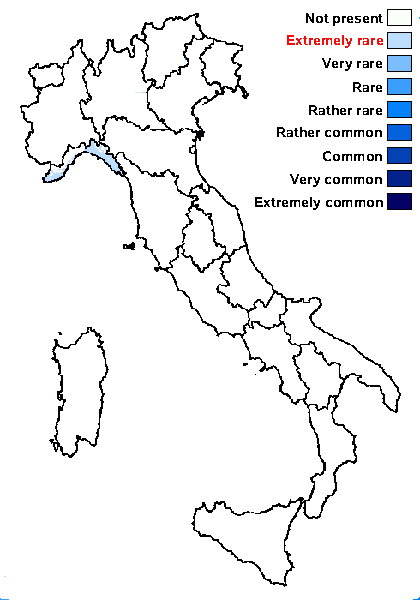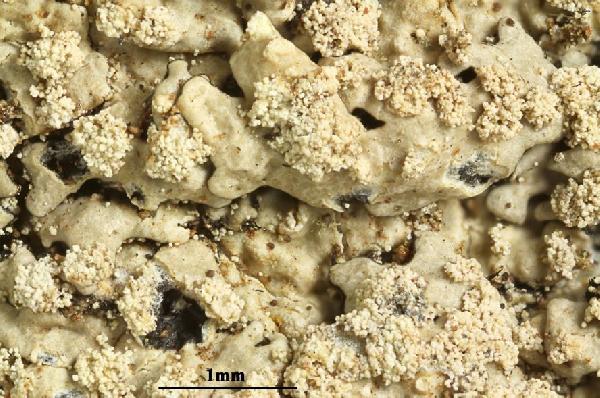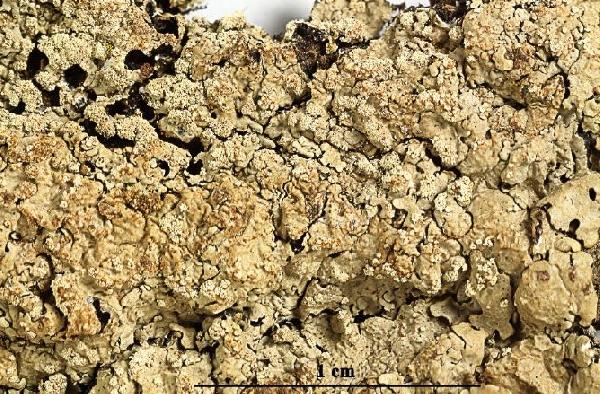Crespoa carneopruinata (Zahlbr.) Lendemer & B.P. Hodk.
N. Amer. Fung., 7, 2: 3, 2012. Basionym: Parmelia carneopruinata Zahlbr. - Sber. Akad. Wiss. Wien, Math.-naturw. Kl., Abt. 1, 111: 419, 1902.
Synonyms: Canoparmelia carneopruinata (Zahlbr.) Elix & Hale; Parmelia sbarbaronis B. de Lesd.; Parmotrema carneopruinatum (Zahlbr.) D. Hawksw.; Pseudoparmelia carneopruinata (Zahlbr.) Hale
Distribution: N - Lig (Watson 2014).
Description: Thallus foliose, heteromerous, dorsiventral, closely adnate, sorediate, forming 2-5(-8) cm wide rosettes. Lobes sublinear, 0.8-2(-3) mm wide, rounded and eciliate at apices, grey, reticulately ridged, wrinkled and cracked, fragile, sometimes pruinose, with laminal soralia developing along the margins of cracks; soredia yellowish orange, granular. Lower surface black in central parts, with simple, black, short rhizines, the marginal parts brown, erhizinate, somehow shiny. Upper cortex of tightly packed, anticlinally oriented hyphae, with a pored epicortex; medulla white, but often yellow to yellowish orange below soralia; algal layer continuous; lower cortex prosoplectenchymatous, with rounded and thick-walled cells. Apothecia extremely rare, lecanorine, 0.8-4 mm across, with a brown disc and a usually sorediate, sometimes pruinose thalline margin. Asci 8-spored, Lecanora-type. Ascospores 1-celled, hyaline, ellipsoid, 9-13 x 6-9 μm. Photobiont chlorococcoid. Spot tests: upper cortex K+ yellow, C-, KC-, P+ yellow; medulla K+ orange, C-, KC-, P+ orange-red. Chemistry: cortex with chloroatranorin and atranorin; medulla with stictic (major), constictic and cryptostictic (minor or traces) acids.Note: a mainly epiphytic, tropical-subtropical species with a single record from Liguria; closely related to C. crozalsiana.
Growth form: Foliose, broad lobed
Substrata: bark
Photobiont: green algae other than Trentepohlia
Reproductive strategy: mainly asexual, by soredia, or soredia-like structures (e.g. blastidia)
Most common in areas with a humid-warm climate (e.g. most of Tyrrenian Italy)
Commonnes-rarity: (info)
Alpine belt: absent
Subalpine belt: absent
Oromediterranean belt: absent
Montane belt: absent
Submediterranean belt: absent
Padanian area: absent
Humid submediterranean belt: extremely rare
Humid mediterranean belt: extremely rare
Dry mediterranean belt: absent

Predictive model
Growth form: Foliose, broad lobed
Substrata: bark
Photobiont: green algae other than Trentepohlia
Reproductive strategy: mainly asexual, by soredia, or soredia-like structures (e.g. blastidia)
Most common in areas with a humid-warm climate (e.g. most of Tyrrenian Italy)
Commonnes-rarity: (info)
Alpine belt: absent
Subalpine belt: absent
Oromediterranean belt: absent
Montane belt: absent
Submediterranean belt: absent
Padanian area: absent
Humid submediterranean belt: extremely rare
Humid mediterranean belt: extremely rare
Dry mediterranean belt: absent

Predictive model
 Index Fungorum
Index Fungorum
 GBIF
GBIF




